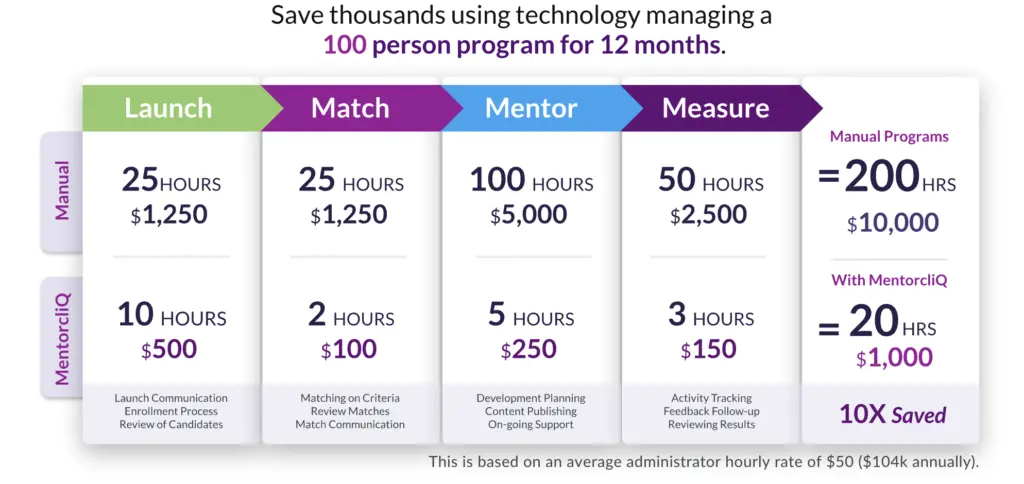Workplace myths are so common it’s often hard to tell the difference between fact and fiction. Take, for example, the belief that hours work = more productivity. That’s been debunked multiple times. Instead, working more efficiently and taking more breaks leads to more productivity. Myths about mentoring abound in much the same way.
Mentoring myths run the gamut on topics such as:
- You can only be a mentor if you’re at a senior level (FALSE)
- Mentoring happens best in person (SUPER FALSE)
- Mentors and mentees need to be matched by hand (BIG ‘OL FALSEHOOD)
While mentorship can look different across organizations, there are certain truths about it that are universal, even if they aren’t always immediately recognized. As good as differing perspectives might be, they can, unfortunately, result in some common myths that lead HR, Talent Development, and Executive Leaders to make the wrong decisions with their mentoring program strategies.
Let’s take a quick dive into some of the most common mentoring myths we typically see and explore why they simply aren’t true.
1. Being an effective mentor requires a significant time investment
Whenever we hear about mentoring program admins struggling to recruit mentors, there’s a common refrain: “Our people say they don’t have enough time to be a mentor.” That’s understandable. An Inc and Go survey found that 95% of employees feel external pressure to overwork.
Most people feel like they’re crunched for time these days. If you ask them to be a mentor on top of that, their first inclination is to stare down their overloaded calendar, get a sinking feeling in their gut, and land on “not right now” as their answer.
Most of that “no” comes down to a misunderstanding of how much time it actually takes to be an effective mentor. Effective mentorship can easily take place in short, sharp bursts (or what we refer to as flash mentoring) so long as they are adequately structured.
By offering visibility on how little time is needed to make a huge difference in someone’s career, admins can increase the positive response rate and boost mentor signups. After all, some time here and there will always begin to add up.
Even if your mentors can only manage 15 minutes every week or an hour every month, that adds up. A full 12 hours of mentoring during a 1-year mentoring cycle can make a big difference.
2. Running an effective mentoring program requires a significant time investment
This myth is exceptionally pervasive, especially among executive leaders looking at the cost to launch and manage mentoring programs. It’s often one of the chief reasons many leaders only sign off on small, manually-run pilot programs that are doomed to failure.

The idea that mentoring programs require too much time to run at scale has been a myth for years, although it’s certainly the reality for companies that are still focused on a manual approach. Companies that leverage mentoring software reduce both the time and cost to run programs, resulting in far better results and allowing them to increase the number of participants with far fewer administrative resources.
By the numbers: A 100-person program running over a 12-month cycle will require about 200 hours of admin time, while that same program running on a mentoring platform like MentorcliQ requires just 20 hours.
Take it with you:
Stuck between manual matching and software? Download our free definitive guide: The Darkside of Manual Mentoring
3. Mentors must be subject matter experts
Mentors are supposed to be able to teach their mentees something, so it only makes sense that they pass on guidance based on your specialties…right?
Wrong! This is one of the more common mentoring myths and one reason mentors sometimes hesitate to sign up. This is particularly true for mentors who are still reasonably early in their careers, e.g., individuals with only a few years of experience under their belts compared to others who have 10+ years working in their field.
It doesn’t take being an expert in something to be able to assist others who are still learning. All it takes is having more experience and thoughtful knowledge than the mentee. Mentoring is a process. Most people will engage with a mentor, grow in that relationship, and then engage with a new mentor after reaching pivotal points in their growth.
One need not be an expert in a field or area of study. All it takes is having experience enough to where you have something you can share. This is why peer mentoring relationships are so valuable. More junior-level employees can easily learn from each other and strengthen each other as they grow together in their careers.
4. Mentoring needs to take place in person to be impactful
Just as effective mentorship does not have to be time-consuming, mentoring does not need to take place in person to be considered impactful. Virtual mentoring is just as effective, if not more so, because of a few reasons:
- For large enterprise businesses, removing location from the matching criteria can reveal higher-quality matches.
- Many employees continue to prefer working remotely. Remote or virtual mentoring gives them the freedom to meet at a time that’s better for their schedules.
- Virtual mentoring can be far more cost-effective for businesses with a large number of employees
In the age of digital communication, there are plenty of ways to keep each other updated. Scheduling regular, short video meetings can be great for keeping each other on track and ensuring progress is made toward any goals set.
A schedule of regular check-ins can even be more successful than infrequent in-person meetings. It all depends on the mentor and mentee at the heart of the relationship.
5. Mentoring is only for leadership development
We understand why one of the myths about mentoring is that mentorship is only for leadership development, but it’s far from the truth.
Yes, those stepping into positions of leadership for the first time will benefit from mentoring programs as they try to find their own style and confidence. Equally, someone well-established in their career might decide to reach out to a mentor if they feel part of their career progression stagnating.
Whether someone is one month into their career or fifty years, there are always new skills to learn and developments to be made. It is never too late to for them to reach out someone for advice and mentorship.
This is why open mentoring programs have so much value. They allow anyone to identify their own personal growth needs, locate an individual within their organization who has experience in that area, and then pair with them organically and on an ad-hoc basis.
6. Mentors are always more senior, and mentees are more junior
A mentoring relationship is all about the transfer of knowledge and experience, so it there’s some intuitive sense in the idea that mentors should be seniors and mentees should be juniors. Yet it doesn’t and shouldn’t work that way so strictly.
Great mentors can be of any level of seniority and can have plenty of insights to share with their colleagues. Placing a junior member of staff to act as a mentor to a more senior coworker is referred to as reverse mentoring. It is a brilliant way to bridge generation gaps within a workplace and can be a fantastic route for fostering diversity and inclusion.
Even more so, Gen Z is predicted to make up about 30% of the workforce by 2030. This generation values inclusion and flexibility in their roles, making them great candidates for reverse mentoring. There are plenty of insights they can bring to a partnership that will help to make their organizations more welcoming overall.
7. Mentoring is the same as coaching, therapy, or sponsorship
Mentoring is often confused with different types of learning, such as coaching and therapy, or other types of professional relationships, like sponsorship. All of these engagements involve discussion and focus on personal growth. The difference between them lies in the dynamic between the mentee and the mentor, and the structure of the engagement itself.

The differences between all three are subtle, as you can see from above, but there is a distinction between them.
A mentor will talk with their mentee and set up unique mentoring goals that address their concerns and personal development as they best see it. Even if the mentor is responsible for multiple mentees, no two programs among them should look the same.
A coach will have a program they wish their student to follow. A therapist will recommend a plan of action based on what their patient reveals to them. A mentor guides their mentee down the path that they mutually build together.
8. Only mentees benefit from mentoring relationships
This is one of the myths about mentoring that will never make sense. According to LinkedIn’s 2023 Workplace Learning Report, 83% of organizations wish to build a people-centric culture. If only mentees benefited from mentoring relationships, they would not exist in the first place. Luckily, the right mentoring relationship will be mutually beneficial to both the mentor and their mentee and will form one of the many building blocks of an organization’s people-centric future.
Business leaders choose to engage in mentoring for a variety of reasons. They may wish to offer support to a junior employee they see potential in. They could wish to give back to their communities. They may even just want to find different perspectives that could shape their own behaviors.
Each of these could bring new skills and insights to the mentor that they can then apply in their own working life, leading to new levels of success and higher levels of job satisfaction.
9. Mentoring is a feel-good thing but not measurable
Part of this myth rests in a misunderstanding of why mentoring is important and the outcomes that exist when mentoring programs are properly structurally and planned around specific, measurable outcomes. Successful mentoring relationships can be measured in both quantitative and qualitative ways, but only if the program was designed in a way that this data can be captured routinely and analyzed easily for insights.
Measuring the success of mentoring programs can involve collecting and analyzing data that includes (but is far from limited to)
- Participant retention rates (especially when compared to non-participants)
- Retention savings
- Satisfaction (often conducted through surveys)
- Promotion rates (especially participants vs non-participants)
- Mentoring program ROI
Now, we’re not saying you need to go full economist and do a whole difference-in-difference estimation (although that would probably go a long way to proving the value of your programs). One of the easiest ways to get this kind of data is to use an integrated mentoring platform like MentorcliQ that securely utilizes your HRIS data and offers quick, automated surveys for feedback.
By tracking measurable aspects of the relationship, we can determine where adjustments are needed in other parts of mentoring relationships and have data ready to go to help explain the value of providing and expanding mentoring programs.
10. Admins should personally match mentors and mentees
One of the biggest hurdles we’ve seen from admins struggling to get their programs to work is the idea that they have to personally match every mentor and mentee by hand. Many admins feel a sense of duty to personally create, send, retrieve, and review every participant profile, then make independent or committee-based decisions on mentoring pairs.
This is not only an impractical approach, but one that introduces a significant amount of bias into the relationship. Ultimately, matching every participant limits how many participants you can have and leads to lower-quality outcomes.
This is not a dig at admins at all.
But let’s face it: The human mind can only process so much information. That’s why computers and algorithms and now AI exist in the first place. They process big data in ways we can’t, with more accuracy than we can do on our own.
The same applies to matching mentors and mentees. A software-based approach removes bias from the equation and allows mentoring program admins to match participants are a much larger number of criteria. The end result is higher-quality matches and far better program results with the data to prove it.
There’s one truth every mentor should know…
Of all the common mentoring myths we have debunked above, there is one truth that we wish to finish with.
There is no such thing as a one-size-fits-all approach to mentoring.
Every single mentoring relationship will be shaped uniquely by the mentor and the mentee engaging in it. Everyone who enters into a mentoring relationship will bring something new to the table. Whether they are the mentor or the mentee, their unique experiences will shape their learning and growth from the scheme, so it is important that the mentoring program at their back is flexible enough to support whatever their vision might be.
Whether you’re looking to launch your first mentoring program or replace an existing one, our employee mentoring software helps boost employee retention rates by up to 75%.
Bust the myth that mentorship is a waste of time; book a demo today and see how MentorcliQ can make your mentoring legendary.




